|
This
Article is from
MustangandFords.com
Clevor Engine:
Mating 351
Cleveland Heads
To 289/302/352W
Blocks
Bush Performance
Engines Brings
Back The Street
Boss And Track
Boss Intakes For
Mating Cleveland
Heads To Windsor
Blocks
By Jim Smart
Photography: Jim
Smart
The most
popular,
low-buck heads
for making power
from a
small-block Ford
are the 351W
versions with a
nice port job,
which makes for
a snappy 289/302
without selling
the farm. But
Bush Performance
Engines in Fort
Smith, Arkansas,
has taken the
concept a step
further by
bringing back
the Clevor
engine, a
package that
mates the large
intake ports of
the 351
Cleveland heads
to the
289/302/351W
blocks for
affordable
small-block
performance.
This is the next
step up when
351W heads just
don’t get it
done.
Performing the
swap requires
some minor
machining and a
special intake
manifold to mate
the
Cleveland-style
heads to the
Windsor block.
Back in the
’80s, B&A
Performance
offered these
manifolds in
both Street Boss
(dual-plane) and
Track Boss
(configuration),
with versions
for the wider
351 Windsor
blocks as well,
but manifold
production was
discontinued
several years
ago. Bush
Performance
Engines has
picked up the
rights to
produce the
manifolds so
they are once
again available,
except for the
351 Street Boss,
for building
street or track
versions of the
Clevor
small-block.
To understand
what it takes to
build a
351C-headed
small-block
Ford, you need
to know the
differences
between the
Windsor-style
and
Cleveland-style
engines. Because
the 351C employs
vastly different
cylinder heads,
with canted
valves, than the
289/302/351W,
the pistons are
designed for a
different
combustion
chamber. The
351C was
available two
basic ways: with
four-barrel
heads with large
ports and closed
wedge chambers,
or with
two-barrel heads
with smaller
ports and open
chambers. The 4V
heads perform
best at high
revs, making the
most of those
huge intake
ports and
high-compression
wedge chambers.
It does not make
a good street
head because
torque is
available only
at high rpm. The
2V heads sport
smaller, more
street-friendly
intake ports and
open chambers
for lower
compression,
facts that make
the 2V head more
useful on the
street where
good low-end
torque is
needed. The 2V
head was also
used on the
later 351M and
400M engines.
Heads Of The
Pack
When building a
Clevor Ford
small-block, the
351C-4V head is
the best choice
only if you’re
reaching for
high revs. This
head has huge
ports and
closed,
high-compression
wedge chambers.
The larger ports
work best at
high rpm because
that’s where we
have air
velocity, which
makes torque.
Closed chambers
yield higher
compression
ratios, which
means power. The
351C-2V head is
designed for
low-rpm street
use. It’s
perfect for a
street driver
because the
smaller ports
provide air
velocity at
lower engine
speeds. Again,
air velocity
makes torque.
The larger, open
chambers yield a
lower
compression
ratio for use
with today’s
pump gas. With
the right
piston, you can
achieve 10.0:1
compression with
this head.
The Australian
Cleveland head
offers the best
of both
worlds--smaller
ports (like the
351C-2V head)
for low-end
torque and
closed wedge
chambers (like
the 351C-4V
head) for power
increases.
Aussie heads are
also available
from Bush
Performance.
Bush Performance
modifies 351C
heads for
installation on
the 289/302/351W
block,
eliminating one
water passage
while creating
another. Bush
closes off the
351C water
passage between
the head and the
block. Then a
passage is bored
in the
forward-most
part of the head
at the intake
manifold, which
allows coolant
to flow to the
289/302/351W
manifold and
thermostat.
The two 351C
head types call
for two types of
pistons--one for
a closed-wedge
chamber and
another for an
open-chamber
design. The
351C-4V piston
is the same
basic slug used
in the ’69-’70
Boss 302 engine
because the Boss
head is
virtually the
same as the
351C-4V head
except for
water-passage
differences.
(The ’69 Boss
302 was actually
the first
application,
from the
factory, of the
351C-4V heads on
a Windsor
block).
The common
denominator for
289/302/351W
power is the
Cleveland head.
Your mission
determines head
selection. For
the street,
choose the
351C-2V heads
with the Street
Boss intake. For
track use, step
up to the
351C-4V heads
with the Track
Boss
single-plane
intake.
![]() |
![]() |
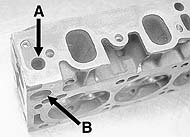
To allow for the differences in coolant flow between the 351C heads and the 289/302/351W blocks, the Bush Performance Clevor heads sport simple modifications. Because the 351C has a dry intake manifold, coolant doesn’t flow between the head and the manifold, flowing instead through the block-mounted thermostat. With the 289/302/351 Windsor engines, coolant flows from the head into the intake manifold where it flows through the manifold-mounted thermostat. The first 351C head modification is to bore a hole in the head (A) to allow coolant flow into the 289/302/351W intake manifold. Bush Performance closes off the cooling passage between the head and block by making a round hole out of a square hole. Then it plugs the round hole with a freeze plug (B). Additional water jacket holes are drilled in the block as shown for better cooling.
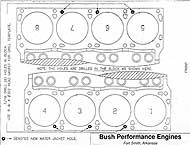
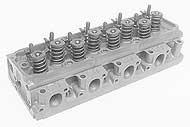
The
Street
Boss
Clevor
gets the
351C-2V
head.
|
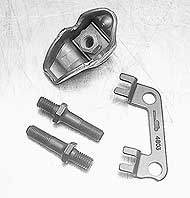
Bush
Performance
builds
these
heads
with
screw-in
studs
and
pushrod
guide
plates
from
Competition
Cams.
|
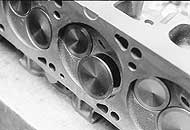
Bush
Performance’s
351C-2V
heads
get
stainless
steel
valves
and
hardened
valve
seats,
making
them a
street
head for
the long
haul.
|
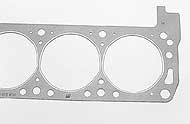
Special
engine
packages
call for
specialized
gasket
needs.
Clevor
Street
and
Track
Boss
engines
get head
and
intake
manifold
gaskets
available
only
from
Bush
Performance.
|
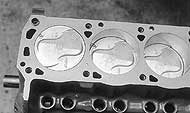
Street
Boss
Clevors
get
forged
pistons
designed
for the
351C-2V
head
with
open
chambers.
Figure
on
10.0:1
compression
with
this
piston
depending
on
compression
height.
|
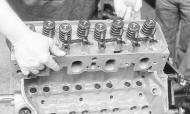
The
beauty
of the
Bush
Performance
Clevor
package
is these
guys
have
done the
homework,
making
it easy
for you
to
groove
into
351C
power
without
the
Cleveland
block.
|
|
|
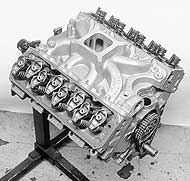
|

The
351C-2V
is the
perfect
street
head due
to its
is
right-sized
ports
and open
chambers
designed
for
lower-octane
fuels.
Bush
Performance
bores a
cooling
passage
(arrow)
in this
head,
which
makes it
a
perfect
match
for the
289/302/351W-style
intake.
|
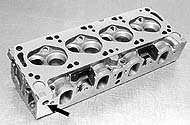
The
351C-4V
head is
great
for
high-revving
engines
thanks
to huge
ports
and
closed
wedge
chambers.
Bush
Performance
takes
this
head and
bores a
water
passage
(arrow)
for the
289/302/351W
induction.
|
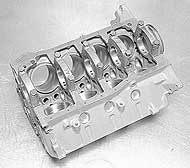
Bush
Performance
likes to
build
quality
engines
that
stay
together.
This is
one
example,
an E4AE
351W
block
that’s
machined
and
ready
for a
Clevor
buildup.
|
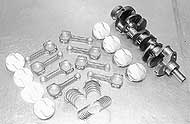
The
bottom
end
includes
a
balanced
stroker
assembly
with
forged
pistons,
cast
crank,
and
cap-screw
connecting
rods.
Piston
selection
depends
upon
head
choice.
These
are
pistons
for the
351C-2V
head
with
open
chambers.
|
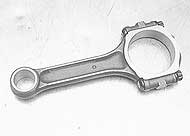
This is
a strong
cap-screw
I-Beam
rod for
Bush
Performance’s
Clevor
stroker.
Because
this is
an
I-Beam
rod, it
is
affordable
yet
nearly
indestructible.
|
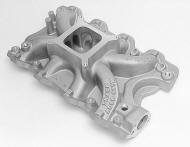
The 351
Windsor
has a
wider
block
than the
289/302
small-blocks,
so it
requires
a wider
intake
manifold.
This is
the
Track
Boss
intake
for 351W
applications
with
351C
heads.
Because
this is
a
single-plane
design,
it only
makes
sense
for high
rpm use.
It is
not
designed
for the
street.
|
|
 |
|
Bush Performance
Engines
4521 S. 16th St.
Fort Smith, AR 72901
(800) 890-4588
(501) 646-9108
|
![]()
![]()
